Windmill: Difference between revisions
m Reverted edits by 71.112.83.128 (talk) to last version by Wtshymanski |
Wtshymanski (talk | contribs) merging windpump |
||
| Line 29: | Line 29: | ||
Windmills and related equipment are still manufactured and installed today on farms and ranches, usually in remote parts of the western United States where electric power is not readily available. The arrival of electricity in rural areas, brought by the Rural Electrification Administration ([[REA]]) in the [[1930s]] through [[1950s]], contributed to the decline in the use of windmills in the US. Today, the increases in energy prices and the expense of replacing electric pumps has led to an increase in the repair, restoration and installation of new windmills. |
Windmills and related equipment are still manufactured and installed today on farms and ranches, usually in remote parts of the western United States where electric power is not readily available. The arrival of electricity in rural areas, brought by the Rural Electrification Administration ([[REA]]) in the [[1930s]] through [[1950s]], contributed to the decline in the use of windmills in the US. Today, the increases in energy prices and the expense of replacing electric pumps has led to an increase in the repair, restoration and installation of new windmills. |
||
==Windpumps== |
|||
A '''windpump''' is a windmill used for pumping water from a [[water well|well]] or draining land. |
|||
[[Image:Windpump8414.JPG|thumb|right|A midwestern wind pump in [[Arlington, Indiana]]. The machanism connecting the wheel to the pump is missing.]] |
|||
[[Image:Wicken_Fen_Windpump.jpg|thumb|The windpump at [[Wicken Fen]].]] |
|||
On [[United States|US]] [[farm]]s, particularly in the midwest, windpumps of the type pictured were used to pump [[water]] from farm wells for [[cattle]]. Today this is is done primarily by [[electric]] pumps, and only a few windpumps survive as unused relics of a previous technology. |
|||
Windpumps similar in construction the ones from the [[United States|US]] midwest is still being used extensively in [[Southern Africa]]. |
|||
[[The Netherlands]] is well known for its windmills. These iconic structures situated along the edge of [[polders]] are actually windpumps, designed to drain the land. These are particularly important as much of the country lies below [[sea level]]. |
|||
==UK== |
|||
As with the Dutch area of [[Holland]] with which it shares some similarities, many windpumps were built in [[The Broads]], of [[East Anglia]] for the draining of land. They have since been mostly replaced by electric power but both the preserved and derelict structures dot the landscape. |
|||
'''Tower mills:''' |
|||
*[[Berney Arms|Berney Arms Mill]], [[Norfolk]] |
|||
*[[Horsey Mill]] |
|||
'''Post mills:''' |
|||
*[[Clayrack Hollow Post Mill]], [[Norfolk]] |
|||
*[[Palmers Hollow Post Mill]] |
|||
'''Smock mills:''' |
|||
*[[Herringfleet Mill]] |
|||
'''To be categorised:''' |
|||
*[[Priory Mill]], [[St. Olaves]] |
|||
*Boardman's Mill, open framed timber trestle windpump |
|||
*Briggate Mill |
|||
*Stracey Arms Mill |
|||
*[[Lockgate Mill]] |
|||
*[[Muttons Mill]] |
|||
*High's Mill |
|||
*Cadge's Mill |
|||
*Kerrison's Level Mill |
|||
*Runham Swim Mill |
|||
*Windpump, [[Wicken Fen]] |
|||
*[[Brograve Mill]] |
|||
*[[Lambrigg Mill]] |
|||
==Modern windmills== |
==Modern windmills== |
||
[[Image:Turbine aalborg.jpg|100px|thumb|Modern windmill in [[Aalborg]], [[Denmark]]]] |
[[Image:Turbine aalborg.jpg|100px|thumb|Modern windmill in [[Aalborg]], [[Denmark]]]] |
||
Modern windmills properly called [[wind turbine]]s or wind generators and |
Modern windmills are properly called [[wind turbine]]s or wind generators and generate electricity. |
||
== Further reading == |
== Further reading == |
||
| Line 73: | Line 115: | ||
*{{dmoz|Science/Technology/Energy/Renewable/Wind/Windmills/|Renewable energy: Windmills}} |
*{{dmoz|Science/Technology/Energy/Renewable/Wind/Windmills/|Renewable energy: Windmills}} |
||
*[http://flowerdew.org 1st English Post Windmill, Virginia] |
*[http://flowerdew.org 1st English Post Windmill, Virginia] |
||
* [http://www.tribology.co.uk/poldaw.htm Poldaw Windpumps], intended principally for applications in developing countries. |
|||
[[Image:horsey_mill_7.jpg|left|frame|300px|Horsey Windpump in Norfolk Broads, [[United Kingdom]].]] |
|||
===History links=== |
===History links=== |
||
*{{dmoz|Arts/Architecture/Building_Types/Mills/Windmills/|Architecture: Windmills}} |
*{{dmoz|Arts/Architecture/Building_Types/Mills/Windmills/|Architecture: Windmills}} |
||
| Line 92: | Line 139: | ||
[[Category:Mills]] |
[[Category:Mills]] |
||
[[Category:Sustainable technologies]] |
[[Category:Sustainable technologies]] |
||
[[Category:Agricultural buildings]] |
|||
[[Category:Pumps]] |
|||
[[de:Westernmill]] |
|||
[[bs:Vjetrenjača]] |
[[bs:Vjetrenjača]] |
||
Revision as of 01:03, 25 February 2007
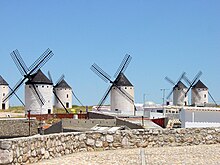
A windmill is an engine powered by the wind to produce energy, often contained in a large building as in traditional post mills, smock mills and tower mills. The energy windmills produce can be used in many ways, traditionally for grinding grain or spices, pumping water, sawing wood or hammering seeds. Modern wind power machines are used for generating electricity and are more commonly called wind turbines.
History
Early history
Windmills have existed for at least 1,300 years. The first windmills had vertical shafts with rectangle shaped blades and appeared in Persia around the 7th century AD, though they were quite different from the European versions. Made of six to twelve sails covered in reed matting or cloth, they were used to grind corn or draw up water. A similar type of vertical shaft windmill with rectangle blades, used for irrigation, can also be found in 13th century China. The horizontal-shaft windmill was developed and built in Europe in the twelfth century. People still use rectangles for the blade shapes.
In Europe
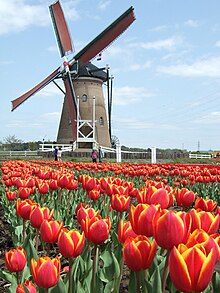
In Europe, windmills were developed in the Middle Ages. The earliest windmills were used to grind cereals and the earliest records date from the last quarter of the twelfth century in the triangle of northern France, eastern England and Flanders. The evidence at present is that the earliest type was the post mill, so named because of the large upright post on which the mill's main structure (the "body" or "buck") is balanced. By mounting the body this way, the mill is able to rotate to face the (variable) wind direction. By the end of the thirteenth century the masonry tower mill, on which only the timber cap rotated rather than the whole body of the mill, had been introduced. Due to the fact that only the cap of the tower mill needed to be turned the main structure could be made far larger, enabling the sails to catch more wind and be made longer. The smock mill is a later variation of the tower mill, constructed of timber and originally developed in the sixteenth century for land drainage. With some subsequent development mills became versatile in windy regions for all kind of industry, most notably grain grinding mills, sawmills (late 16th century), threshing, and, by applying scoop wheels, Archimedes' screws, and piston pumps, pumping water either for land drainage or for water supply.
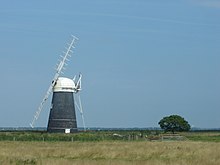
With the industrial revolution, the importance of windmills as primary industrial energy source was replaced by steam and internal combustion engines. Polder mills were replaced by steam, or diesel engines. The industrial revolution and increased use of Steam and later Diesel power however had a lesser effect on the Mills of the Norfolk Broads in the United Kingdom, these being so isolated (on extensive uninhabitable marshland), therefore some of these mills continued use as drainage pumps till as late as 1959. More recently historic windmills are being preserved for their historic value, which requires regular use because the wooden machinery is likely to be destroyed by woodworm and dry rot when the mill remains stationary for too long.
With increasing environmental concern, and approaching limits to fossil fuel consumption, wind power has regained interest as a renewable energy source. This new generation of wind mills produce electric power and are more generally referred to as wind turbines.
See Flood control in the Netherlands for use of windmills in land reclamation in the Netherlands.
In the United States
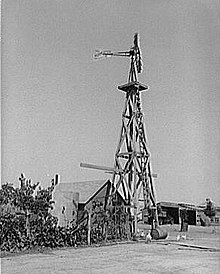
The development of the water-pumping windmill in the USA was the major factor in allowing the farming and ranching of vast areas of North America, which were otherwise devoid of readily accessible water. They contributed to the expansion of rail transport systems throughout the world, by pumping water from wells to supply the needs of the steam locomotives of those early times. They are still used today for the same purpose in some areas of the world where a connection to electric power lines is not a realistic option.
The multi-bladed wind turbine atop a lattice tower made of wood or steel was, for many years, a fixture of the landscape throughout rural America. These mills, made by a variety of manufacturers, featured a large number of blades so that they would turn slowly but with considerable torque in low winds and be self regulating in high winds. A tower-top gearbox and crankshaft converted the rotary motion into reciprocating strokes carried downward through a pole or rod to the pump cylinder below.
Windmills and related equipment are still manufactured and installed today on farms and ranches, usually in remote parts of the western United States where electric power is not readily available. The arrival of electricity in rural areas, brought by the Rural Electrification Administration (REA) in the 1930s through 1950s, contributed to the decline in the use of windmills in the US. Today, the increases in energy prices and the expense of replacing electric pumps has led to an increase in the repair, restoration and installation of new windmills.
Windpumps
A windpump is a windmill used for pumping water from a well or draining land.
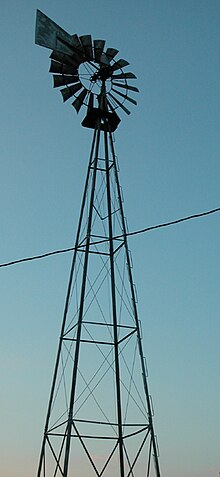
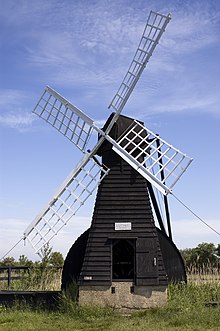
On US farms, particularly in the midwest, windpumps of the type pictured were used to pump water from farm wells for cattle. Today this is is done primarily by electric pumps, and only a few windpumps survive as unused relics of a previous technology.
Windpumps similar in construction the ones from the US midwest is still being used extensively in Southern Africa.
The Netherlands is well known for its windmills. These iconic structures situated along the edge of polders are actually windpumps, designed to drain the land. These are particularly important as much of the country lies below sea level.
UK
As with the Dutch area of Holland with which it shares some similarities, many windpumps were built in The Broads, of East Anglia for the draining of land. They have since been mostly replaced by electric power but both the preserved and derelict structures dot the landscape.
Tower mills:
Post mills:
Smock mills:
To be categorised:
- Priory Mill, St. Olaves
- Boardman's Mill, open framed timber trestle windpump
- Briggate Mill
- Stracey Arms Mill
- Lockgate Mill
- Muttons Mill
- High's Mill
- Cadge's Mill
- Kerrison's Level Mill
- Runham Swim Mill
- Windpump, Wicken Fen
- Brograve Mill
- Lambrigg Mill
Modern windmills
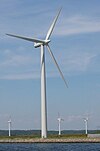
Modern windmills are properly called wind turbines or wind generators and generate electricity.
Further reading
- A.G. Drachmann, "Heron's Windmill," Centaurus, 7 (1961), pp. 145-151
See also
- Renewable energy
- Land reclamation
- List of windmills
- watermill
- tension leg platform
- windpump
- wind generator
- Don Quixote
- Molinology
- The International Molinological Society
- klopotec
More images
-
Pitstone Windmill, believed to be the oldest windmill in the British Isles
-
Windmills of Western Siberia, taken by Prokudin-Gorskii, c. 1910
-
The windmills of Kinderdijk, the Netherlands
-
Double windmill and common Aeromotor windmill in Texas
-
Windmill near Tés
-
Weybourne Windmill, Norfolk, England
External links
- Windmills at Windmill World
- The International Molinological Society (TIMS)
- All About The American Water Pumping Windmill
- Danish Wind Industry Association
- Mill database with over 15000 mills from all over Europe
- Norfolk Mills
- Britannica
- Template:Dmoz
- 1st English Post Windmill, Virginia
- Poldaw Windpumps, intended principally for applications in developing countries.
History links
- Template:Dmoz
- Windmillers' Gazette
- History of the Traditional American Farm Windmill
- windmillworld: history
- American Wind Power Center - An American water pumping windmill museum in Lubbock, Texas USA.
- Shattuck Windmill Museum Thirty-nine water pumping windmills used on the plains; located in Shattuck, Oklahoma
- Illinois Windmills--history and archives for the Dutch windmills in the state.
- How to construct a Windmill
Theory






